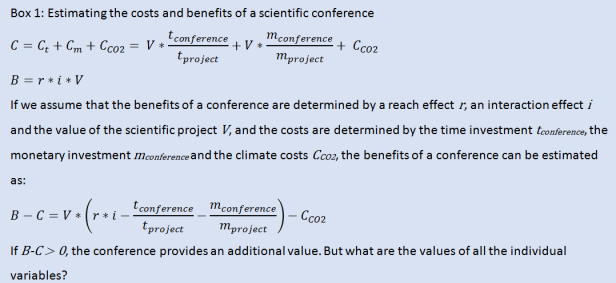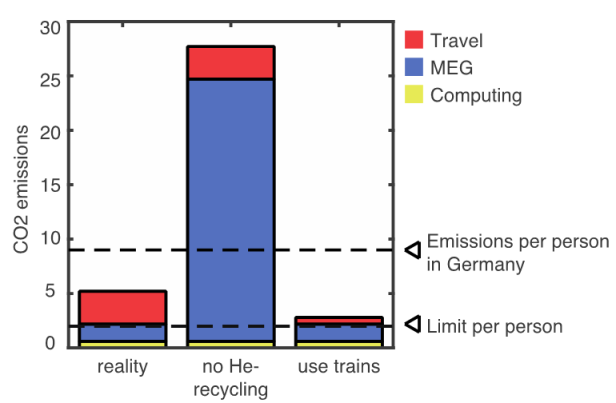Written by Florian Sandhäger
We work in a town with a green mayor, a state with a green prime minister, and a country that aims to effectively eliminate carbon emissions by 2050. While political decisions play an important part, the success of such ambitious goals critically depends on the choices of individuals. In our private lives, many of us are aware of the problem and sometimes even act accordingly: should we buy fruit that has been shipped from South America? Should we take the car or go by bike? Should we use solar or fossil power? Yet, I have seldom seen scientists consider environmental factors in their professional decisions. In my personal life, I try to avoid flying when possible. Yet, in the last couple of years, I have been to North America twice for science.
Is that problematic? There are not that many scientists, after all, and even if all of them spent more time in airplane than in the lab, it wouldn’t affect the climate much. But everyone has a job, every job results in greenhouse gas emission to some degree – and all the earth can take from each of us to ensure a stable climate is 2 tons of carbon dioxide per year, which is about equal to two thirds of a single return flight for one person from Stuttgart to Chicago [1]. Or eating 300 kg of beef. Or two tons of Tofu. Or ten tons of potatoes [2]. Currently, the average person living in Germany emits about 9 tons of CO2 per year, more than four times the sustainable amount [3]. For us, as scientists, it is likely that a large part of our yearly emissions stems from our scientific activities, and most probably more than the two tons each of us should be emitting.
Every human is equal! Therefore, it should be our goal that every human has equal rights to emit carbon dioxide, and, to keep the climate stable, actually stays below the 2-ton boundary. This requires major sacrifices – apart from radical changes in our personal lives we have to stop traveling to conferences, using big and energy-intensive machines, and probably even heating our offices. This radical solution immediately solves the climate problem. But is it a good solution? I, for several reasons, do not think so. Firstly, it is extremely demanding. Everyone would have to change their lives dramatically and give up a lot of fun and many opportunities. Secondly, even if some people are willing to make these sacrifices, they will be perceived as insane fundamentalists by the rest of the world. The bigger the gap between them and everyone else, the less likely they are to ever convince anyone to make a change themselves. And people not willing to go all the way might be discouraged to take even little steps if they cannot expect any recognition for it – they would still be irresponsible annihilators of the climate after all.
Most importantly, this solution only looks at one side of the equation: whatever we do has not only costs, but also benefits. Emission rights should probably not be distributed equally between everyone and every activity – some activities with large benefits might be allowed much greater emissions. It is tempting to assume that science is so beneficial that the costs practically don’t matter: Science is important. Science might give us the progress needed to achieve a sustainable way of life in the future. Science can help the sick and the old, which is certainly more important than buying cars or a vacation in the Maldives. But many things are important, and not all science is equally so. I’d take a bet that there are plenty of scientific activities that actually have less benefits than any individual exotic vacation that, hopefully, at least makes everyone involved a bit happier.
In order to justly assign emission rights, we have to try to accurately estimate all of the costs and benefits of every activity. If the benefits are higher than the costs, we should do it – it’s worth it. But what are the costs and benefits of, say, traveling to a scientific conference? On the cost side, the most obvious points are the time and money that could have been spent otherwise as well as the carbon emissions for travel, accommodation and the conference venue. Benefits include an effect on the outreach of the research presented – if the science has some value and more people are confronted with it, the value will be multiplied – as well as positive influences due to interactions between scholars that can increase the value of the research itself: the concentration of relevant science as well as interesting conversations can help generate good ideas. It might be relatively straightforward to write down an equation capturing all these factors. However, bringing the equation to life can prove extremely difficult. How much more impact does a result make when it is presented at a conference compared to when it’s not? This is not an easy question, but it should be possible to find an empirical answer. What difference does the input of the academic community at a conference make? This one is already quite a lot harder to answer, but it may still be possible to get a good estimate. However, what is the value of a scientific project? Should we use data from the past to assess what average impact each study ever conducted has made? Should we just use the funds a project received as an approximation, because if society is willing to spend a certain amount on it, it must be expected to be worth at least that?
This makes it very difficult to use considerations like this one to make actual decisions about whether a given activity is overall beneficial or not. While it might be helpful to try estimating costs and benefits in this way to get a general feeling for the important factors, we should probably not spend too much time on it or rely on the results blindly.

We cannot immediately stop emitting excess CO2, and we are unable to determine good cost-benefit estimates for most of our decisions. Are we doomed? Do we have to hope for miracles or is there anything else we can do? I believe there is a third way that will ultimately effectively tackle climate impacts while not being too demanding on anyone along the way. All it requires is that more researches gain awareness about the climate costs of their work and are willing to act on this awareness – even if it is only in very little steps, as long as these steps are bigger than the ones that everyone else is taking. The first step in becoming aware is to gain an idea of science’s climate impact. Is it even significant? And are any of the emissions avoidable? In a recent case study, the carbon impact of a 4-year PhD in Environmental Sciences was estimated at 21.5 tons of CO2, which was equivalent to 2.7 tons per paper or 5.4 tons per year, 75% of which was due to travel [4]. As values might be very different for different scientific fields, I tried to crudely estimate the carbon impact of research more similar to my own.
I use Magnetoencephalography (MEG) to measure magnetic fields in the human brain. To function, the MEG has to be continuously cooled using liquid Helium – and 14.5 liters of liquid Helium evaporate in a single day. It is not easy to find information on the carbon footprint of helium production, but helium is mostly obtained as a byproduct from natural gas purification and might therefore have a similar footprint. Under this assumption the 657 kg of Helium required every year lead to the gigantic emission of 241 tons of carbon equivalent [5]. Luckily, the MEG Center installed a recovery system which enables the recycling of about 95 percent of the helium used which – taking into account the energy needed for liquefaction – reduces yearly emissions to about 16 tons of CO2 equivalent. In 2015, groups at the MEG center published 10 papers, leading to an amount of 1.6 tons of CO2 per paper due to the use of MEG.
To process the high-dimensional data the MEG gives us, we need a lot of computing power. For this purpose, my group has a high performance cluster, whose energy consumption I estimate at 7700kWh per year – leading to emissions of about 3 tons of CO2, or 0.6 tons of CO2 per paper published in 2015.
Finally, I will make the assumption of traveling to one international conference per published paper, by airplane, using the distance Stuttgart-Chicago as an example. This leads to another 3 tons of CO2 per paper.
Only a few neuroscientists use MEG. But most of us depend on big, expensive machines, laboratory animal facilities or extensive computing power, all of which have considerable environmental footprints. Most of us like to travel and take opportunities to give talks, attend conferences or courses whenever we can. Therefore, most of us probably emit greenhouse gasses in a similar order of magnitude, even if the individual contributors vary.

Figure 1: CO2-emissions per paper in three scenarios. A) estimated real emissions, B) emissions if no Helium-recycling was performed, C) emissions if the same distance was traveled per paper, but by train instead of airplane. For comparison, yearly emission per person and year in Germany as well as the limit of sustainable emissions per person and year are marked as black lines. Yes, this is a bar graph and I think it’s appropriate [6].
So what can be done? For those of us who are near the bottom of the scientific hierarchy, there is only so much we can do; the most significant factor everyone can influence is probably travel. While there might be a not too distant future in which physical travel is not necessary anymore due to virtual conferences [7], this will not be achieved by personal decisions of single scientists – but if you are not entirely sure whether it is worth going to an international conference, you can let the climate be the decisive factor and give it a miss – or try out a more local meeting that can be reached by train, bus or car.
Those finding themselves in a more powerful position can have a much bigger impact. When organizing conferences, choosing the location dependent on where the likely participants work can drastically cut carbon emissions [8]. While it generally seems more reasonable to bring a limited number of speakers to a big audience, emissions can be further reduced if speakers from remote locations give their talks virtually, which can be supplemented by technical solutions to enable interaction. Additionally, conference organizers can promote climate awareness among their participants by supplying information on alternatives to air travel or emission compensations. For big conferences, it might even be possible to organize additional ground transportation to the conference location.
If you are in the position to acquire scientific equipment, it can make a great difference to investigate alternatives and recycling options such as the MEG center did for the helium cooling. In many cases, this might even be economically useful – the reason to introduce a helium recycling system was an increased independence from the helium market.
Finally, funding bodies and administrators could influence the environmental impact of science by requesting information on climate costs in grant applications and more readily supplying funds for alternatives to travel [9] or cutting bureaucracy (it has been estimated that 44000 pages may be printed for the filling of a faculty position in Greece [10]).
To me, science is inherently directed towards the future. We are building on knowledge that previous generations have gained, and future generations will build upon our work – if they will have a planet to live on that permits sufficiently comfortable conditions for luxuries such as research. While curiosity might still compel us to find out as much about the world as we can, knowing that our branch of intelligent life has no future in the medium term would take away one of the major drives for science. Scientists, I believe, should be and are invested in the future and therefore should care about the climate. And caring means acting – even if it is only in tiny steps. I hope that in the future scientists on all levels will be more aware of the environmental impact of their work. Research has all sorts of costs that we take into account when making decisions – is it worth to take animal lives? Is the time and money well spent on the project? We should take climate costs into account, too.
Please note that all numbers in this article are approximate and are meant to be understood in terms of their order of magnitude.
Florian Sandhäger graduated from the Neural and Behavioral Neuroscience Masters Program ’15. He is currently a GTC doctoral student in the Laboratory of Markus Siegel at the MEG Center and the CIN in Tübingen.

